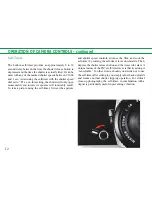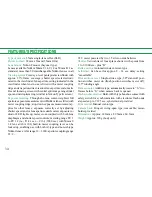
19
DEPTH OF FIELD
When you focus on your subject, you will find that not only
is the subject itself in focus but that objects both in front of
and behind it appear to be in focus. This “zone”of focus is
called “depth of field.”
Depth of field is not a fixed quantity. It varies by lens, de-
pending on both the subject’s distance from the camera and
the specific lens aperture in use. A third factor, the focal length
of the.lens, also influences the apparent depth of field, i.e.,
the longer the lens, the shallower the depth of field appears
to be, and vice versa. In the same manner, the wider the tak-
ing aperture (i.e., the lower the f/stop number), the shallower
the depth of field, and vice versa. Also, the closer you ap-
proach your subject, the shallower the depth of field becomes,
and vice versa. In all cases, you will find that the depth of
field behind the subject is larger than that in front; this en-
ables selective blurring of the background elements of the
picture, a technique most often used by the creative photog-
rapher.
Depth-of-Field Preview Lever
Most of the Nikkor lenses you will find yourself using with
the Nikon FM are “automatic.” This means that the aperture
diaphragm of the lens is kept open at its widest setting while
you are viewing, focusing and metering. When you press the
shutter release button, the camera’s mechanism automatically
“stops down” (i.e., closes the lens aperture) the lens to the
aperture at which it is set.
To examine the depth of field before taking a picture, it is
necessary to stop down the lens manually. You can do this by
exerting slight finger pressure on the FM’s conveniently situ-
ated depth-of-field preview lever. Assuming that the lens is
set to an aperture other than its maximum, gentle pressure on
the lever will stop down the lens to that aperture. You will
then be able to see the elements in front of and behind the
main subject that will appear in sharp focus in the actual pho-
tograph— although some of them may have appeared not to
be in focus prior to pressing the lever. A side effect of this
picture-taking process is the “darkening” of the image in the
viewfinder (the higher the f/number, the “darker” the image
appears); this is normal and should be no cause for concern.
Содержание FM
Страница 1: ...1 INSTRUCTION MANUAL ...
Страница 17: ...17 ...
Страница 23: ...23 ...
Страница 35: ...35 ...
















































